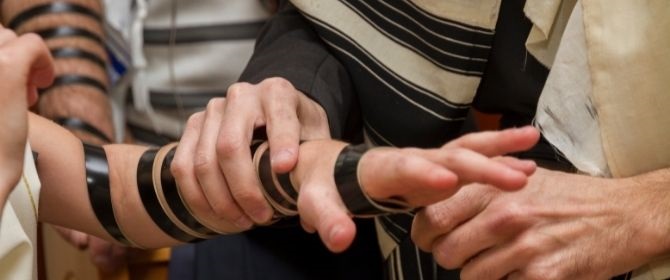A birthday only comes once a year, but it’s important to consider a few things before setting a date for your Bar Mitzvah ceremony.
First, a boy can be called up to the Torah only from the day he turns 13 years and one day old according to the Hebrew date of his birth. Not sure about the Hebrew date? Here’s a calculator to help you calculate it.
Second, the Torah reading occurs only on Mondays and Thursdays during the week, on Rosh Hodesh (the beginning of the Jewish month), or Shabbat. So, to combine the event with the Torah reading, you must choose one of those days.
Tefillin are a central symbol in the Bar Mitzvah ceremony, and the boy is supposed to start wearing them around the time he celebrates his 13th birthday. Whether you buy them yourself or receive them from grandparents, you should know a few things.
For the writing of tefillin, you can approach a qualified scribe (Sofer Stam), and there are larger organizations like Tefillin Beit El, that deal with this subject. Some of these organizations also offer a short tour of the tefillin manufacturing process that provides background information.
Remember that there are different versions of tefillin – Ashkenazi, Sephardi, Yemenite, and Ari’s versions. Also, specify to the seller if you need tefillin for a right-handed or left-handed boy. Remember to consider additional accessories that might be needed, like a tefillin bag. In some traditions, a new tallit (prayer shawl) is also purchased for the Bar Mitzvah boy.
The Aliyah to the Torah (Torah reading) is a meaningful experience for the Bar Mitzvah boy, allowing him to feel the transition to adulthood. As part of the ceremony, the boy reads from the Torah scroll in front of the attendees, a significant and emotional experience that he hadn’t been able to do until that day. Usually, there’s some preparation and learning before this ceremony, including the appropriate reading. This learning can be done with professionals and organizations like Tzohar and Chabad that offer preparation programs, even online.
The Aliyah to the Torah can be held in your local synagogue, another synagogue, or at the more iconic location – the Western Wall. To read the Torah at the Western Wall, you need to coordinate with the Western Wall Heritage Foundation and register in advance on their website. After the event, you’ll receive a personal certificate signed by the rabbi of the Western Wall.
Have you chosen to come to Jerusalem and celebrate your Bar Mitzvah at the Western Wall? Congratulations! You’re in for a special and emotionally significant experience.
The Aliyah to the Torah takes place in the Western Wall Plaza. The plaza is segregated into sections for men and women, allowing you to hold the ceremony near the partition wall. The ceremony requires a minyan (a quorum of ten adult Jewish men), but even if you don’t have ten men in your group, you’ll likely find worshippers at the Wall who can help.
Parking in the Old City of Jerusalem is quite limited. If you’re coming by private car, you can park at one of the paid parking lots in the vicinity:
Karta and Mamilla Parking Lots (Waze). The walk from these parking lots to the Wall is about 20 minutes, so it’s recommended to continue by taxi.
Mount Zion Parking Lot (Waze).
Zion Gate/David’s Tomb Parking Lot (Waze) – The walk from this parking lot to the Wall is about 9 minutes.
Public Transportation to the Western Wall:
Egged – Line 1 – Central Bus Station to the Western Wall.
Egged – Line 3 – Central Bus Station to the Western Wall.
Egged – Line 38 – Jewish Quarter (circular line, passes by the Wall).
Superbus – Line 2 – Kikar Tzahal / Yitzhak Kariv St. (circular line).
Taxis:
Taxis can enter through Jaffa Gate at any hour so that you can reach the Wall by taxi.
Shuttles:
If you’re arriving with a large group to Jerusalem, consider transportation options for all the guests.
You’ve gathered, read, and felt emotional, now hunger is making its presence known. So where can you eat in Jerusalem without straying too far?
Here are a few options:
In the Mamilla shopping complex on Mamilla Street, there are several restaurants. Remember that it’s about a 20-minute walk uphill (Jerusalem has its share of hills) from the Western Wall.
In the City of David National Park, a hospitality area offers refreshments like coffee, pastries, and light snacks. The area is about a 3-minute downhill walk from the Wall, and you can combine it with a musical procession led by musicians. If you’d like, you can continue to a festive lunch area called “King’s Courtyard.”
The City of David also offers an additional value to the Bar Mitzvah event – a private tour for the guests. This complements the connecting experience and adds extra meaning to the emotional ceremony. The tour includes an impressive panoramic view of Jerusalem and guidance among archaeological remains from different periods of Jewish history. The place also allows the Bar Mitzvah boy to participate in the guiding, connecting him even more to Jerusalem – the place of his birth, history, and future.






